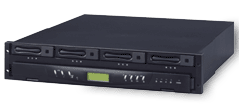| |
JStor-3 IDE 8-bay RAID Array
with MDF (Multiple Drives Failure) capabilities
 Dual SCSI Host Interfaces Dual SCSI Host Interfaces

|
|
Adding another dimension to fault-tolerance, JStor III IDE 2U RAID array with MDF (Multiple Drives Failure) technology delivers reliable RAID 6 data protection combined with the high performance of Ultra160 SCSI host interface to support a wide variety of mission critical business applications. Engineered to meet stringent demands for continuous availability, JStor III IDE RAID array features a brand-new 64-bit RISC processor for blazingly fast I/O operations, ASIC assisted parity calculation, completely cableless backplane-based design, and storage capacities exceeding 2TB in a small 2U enclosure.
Low service and integration costs are assured by the JStor's cableless design, two redundant hot-swappable power supplies, turbo cooling fans, and embedded RAID controller. Three year warranty comes standard with every array and covers all components.
Versatility is in the heart of the JStor III IDE array. Indeed, it can be used as a desktop or be rackmounted into any standard 19" rack cabinet.
JStor III IDE RAID addresses many challenges present in information systems departments and delivers unparalleled storage flexibility, higher levels of data availability, management and configuration simplicity, all while securing maximum investment protection to support future growth.
|

|
Drive capacities of 80GB (7,200 rpm), 120GB (7,200 rpm), 160GB (7,200 rpm), 200GB (7,200 rpm), 250GB (7,200 rpm), 300GB (5,400 / 7,200 rpm) and 400GB (7,200 rpm) are available.
Full 48-bit ATA addressing standard support.
Maximum capacity 3.2TB when using 300GB drives.
|

General
|
| |
RAID Architecture
|
|
64-bit RISC 400MHz CPU with 266MHz memory bus
Up to 1600 Mbytes/sec internal bandwidth
133 MHz PCI-X interface to the backplane
|
| |
Host Bus Interface
|
|
Two, 160 MB/sec. Ultra3 LVD (Low Voltage Differential) SCSI
|
| |
Disk Bus Interface
|
|
Eight master Ultra ATA/133 channels;
48-bit addressing
|
| |
Command Queuing
|
|
253 commands (host SCSI channels)
|
| |
Cache
|
|
Up to 1GB (using one, industry-standard DDR SDRAM)
|
| |
Operating Systems Supported
|
|
Windows Server 2003, Windows 2000 and MSCS (Microsoft Cluster Server), Windows NT, Sun/Solaris, Linux, Tru64 Unix, HP/UX, IBM AIX, SGI IRIX, DEC VMS, MAC OS, FreeBSD, Novell, OS/2, and others to be announced
|
Environmental
|
| |
Temperature
|
|
50°F to 104°F operating, -40°F to +140°F non-operating 10°C to 40°C operating, -40°C to +60°C non-operating
|
| |
Relative Humidity
|
|
10% to 85% non-condensing (operating), 5% to 90% non-condensing (non-operating)
|
| |
Certifications
|
|
FCC, CE, TUV, and UL/CSA
|
Physical
|
| |
Size/Weight
|
|
19" wide, 21" deep, 3.5" (2U) high, 31 lb. / 14 kg. (without disk drives)
|
| |
I/O Connectors
|
|
Four standard 68-pin SCSI, two 9-pin DB9 type RS-232 serial terminal port and fax / pager port; Ethernet management port
|
| |
Power Required
|
|
110 or 220 VAC, ±20% @ 6 amps / 3 amps peak; 47 to 63 Hz. autosensing
|
|
|
Click here for the 16-bay version

JStor III IDE 2U with MDF

JStor III IDE 2U | panel down

|
Exclusive MDF (Multiple Drives Failure) technology (RAID 6) provides the highest level of data protection. Multiple simultaneous drive failures can be tolerated without downtime or data loss.
Dual host connection can support two hosts simultaneously. Perfect for clustered environments, e.g. MSCS - Microsoft Cluster Server.
Full 48-bit ATA addressing standard support allows for up to 144 petabytes capacity per drive to be utilized in the RAID array.
Optional Fiber Channel host interface is available.
RAID controller provides RAID 0, 0+1, 1, 3, 5, and RAID 6, Global Hot Spare Disk, Auto Rebuild, and up to 1GB of DDR SDRAM-based data cache.
Intelligent IDE/ATA backplane design (uses no cables) allows "hot swapping" of disk canisters, power supplies, and fans for increased reliability, lower cost, and ease of maintenance.
Built-in management ethernet port provides easy access to the web-based GUI RAID Manager for configuration, management, and monitoring functions.
Completely user configurable via the front panel.
|
|



